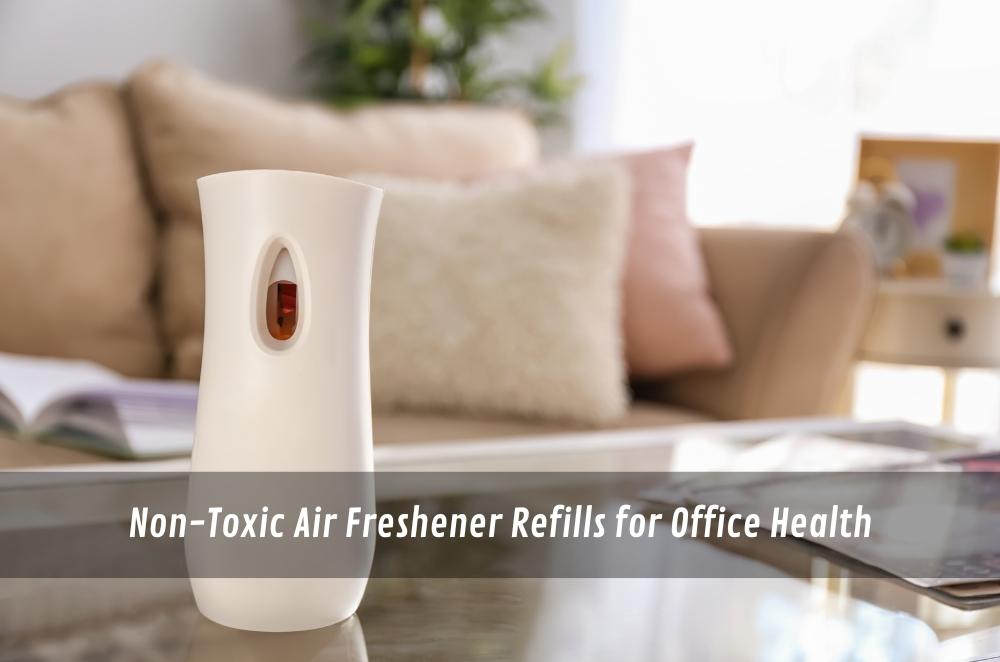Non-Toxic Air Freshener Refills for Office Health

Walk into any office, and the air sets the mood long before anyone speaks. Some spaces feel light and welcoming; others hold a mix of coffee, cleaning products, and stale air. Getting that balance right isn’t about using stronger scents—it’s about understanding commercial air freshener safety and how subtle, well-managed refills can quietly improve comfort without overwhelming the room. When I plan air care for shared spaces, I focus on consistency: measured bursts, good airflow, and products that meet workplace health standards. The goal is to make the space feel clean, not fragranced. A well-placed dispenser does the heavy lifting in the background, keeping kitchens, bathrooms, and meeting areas fresh enough that no one gives it a second thought. It’s a simple adjustment that can transform how people experience an office—clear air, steady energy, and fewer distractions.
Why air freshener refills influence wellbeing
Refills aren’t about masking problems; they stabilise the baseline. Metered output and predictable chemistry help you manage comfort while you fix root causes like airflow, bins or drains. In open-plan floors, a whisper of fragrance is enough. Overdo it and people notice the scent, not the space.
-
Metered dispensers reduce spikes and help you match output to room size.
-
Consistent refills maintain a steady, low background rather than swings.
-
Light, familiar profiles (often citrus or airy herbal) minimise polarising reactions.
-
Clear reporting lines catch sensitivity issues early and keep trust high.
A quick first-hand example: on a 120-person floor, I trialled three settings—light, medium, heavy—across identical bathrooms. Medium cleared odour complaints without drawing attention to itself, while heavy triggered “too perfumey” feedback. The difference wasn’t the brand; it was dose and placement. When we standardised the winning setting, HR tickets dropped and the floor felt calmer.
Practical safety: placement, dosing and feedback
Safety starts with where you mount the unit and how often it fires. Above head height and away from HVAC returns prevents concentrated pockets. Kitchens and bathrooms can handle a touch more output; open plan needs restraint. Keep a fragrance-free desk cluster on each level for colleagues who are sensitive.
-
Place units away from food prep, over desks, and supply vents or returns.
-
Use longer intervals outside peak hours; shorten slightly when traffic rises.
-
Log install date, interval, refill type and model in a shared register.
-
Add a two-week check-in: “too strong / too weak / about right?” then adjust.
Another real-world moment: a lingering “lunch smell” near microwaves wasn’t solved by stronger fragrance. We relocated the dispenser, slowed the interval, and improved early-morning air purges. Complaints fell away. Air care works best when it supports airflow, not when it tries to fight it.
Compliance basics for Australian workplaces
Compliance doesn’t need to feel complicated. Most of it comes down to knowing what’s in your products and using them responsibly. Air fresheners might seem harmless, but when you’re managing shared spaces, you’re accountable for what staff breathe in each day. That’s why I keep a close eye on the regulation of cleaning products and how it shapes safe workplace practices in Australia. The Therapeutic Goods Administration sets the tone for how disinfectants and other air care products are classified, helping facility managers understand when an item crosses into the “regulated” category.
-
Skip medical claims for air refills unless the product is explicitly approved.
-
Keep SDSs easy to access and align usage with WHS documentation.
-
Train cleaners to identify and escalate scent-related complaints quickly.
-
Keep a simple audit trail: settings, changes, batches and responses.
Good documentation feels boring—until it saves you. If someone reports irritation, you’ll want to show when the unit was installed, which refill you used, and what setting it’s on. That paper trail turns a vague concern into a solvable tweak.
Making air care part of cleaning routines
Air fresheners work best when they’re part of a broader, well-organised cleaning process. They shouldn’t be an afterthought or a quick cover-up. I’ve found that when cleaners follow structured routines, it naturally reduces odours before a dispenser ever needs to kick in. That same consistency carries over to how other tools are used around the site—like spray bottles for surface solutions. Knowing the right way of using spray bottles for cleaning reinforces safety, keeps labels visible, and prevents accidental mixing of chemicals.
-
Put dispenser checks on the same run sheet as waste and surfaces.
-
Rotate stock (first-in, first-out) and bin expired or damaged refills.
-
Store upright in a cool cupboard away from off-gassing chemicals.
-
Keep one fallback fragrance on hand to swap quickly after complaints.
The best programs feel boring in the right way: the dispenser fires, the room stays comfortable, and the logbook fills itself in. That quiet predictability is what people notice—by not noticing anything at all.
Balancing scent with brand experience
Scent quietly shapes expectations. A foyer that smells crisp and light hints at tidy operations; a cloying hallway does the opposite. If you collaborate with front-of-house teams, align refills with the mood your brand wants at the door. There’s useful thinking to borrow from scent marketing in detailing—not to turn offices into showrooms, but to keep the air consistent with the space.
-
Choose two dependable year-round profiles and one seasonal accent.
-
Keep open-plan areas minimal; let bathrooms and lobbies do more of the work.
-
Avoid clashing families (e.g., heavy gourmand near bright citrus).
-
Reassess as teams change or spaces are reconfigured.
This is less about chasing novelty and more about keeping the environment coherent. When scent fades into the fabric of the building, people focus on their work rather than the air around them.
Final thoughts
Non-toxic outcomes come from modest ingredients, light touch, and respect for people who share the space. Use metered refills and consistent settings to stabilise comfort, keep SDSs close so decisions stay defensible, and pair air care with the everyday habits your cleaners already do well. Start small, listen, adjust, and document. That’s how a quiet background choice turns into a healthier, calmer office—one that simply feels right when you walk in.








